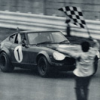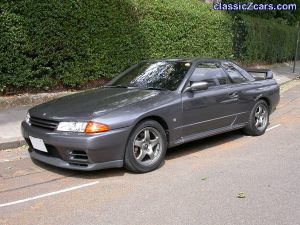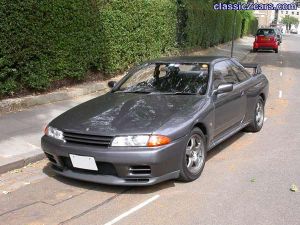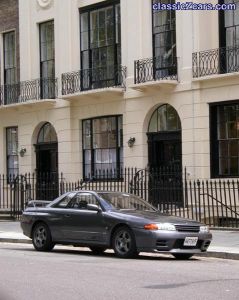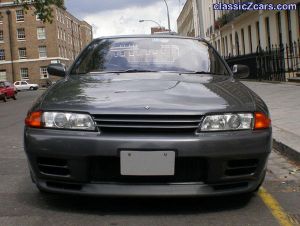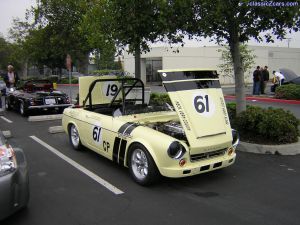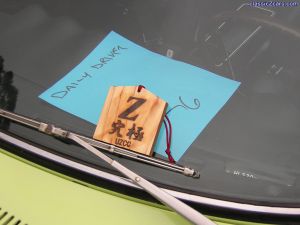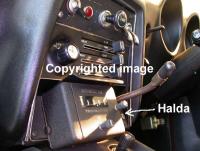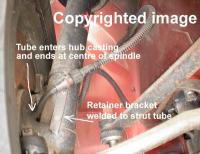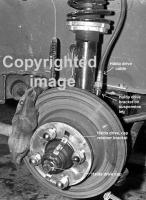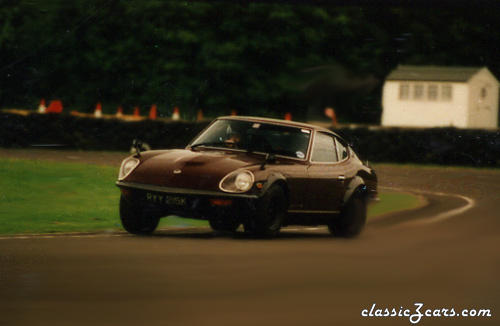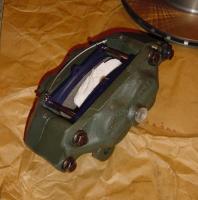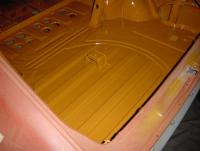Everything posted by HS30-H
- R32 GT-R
- R32 GT-R
- R32 GT-R
- R32 GT-R
-
Big Sam
Nissan achieved more than 200 BHP themselves on all of the Works rally cars which used the L24 engine block, and in fact its fairly simple to get this kind of power. Nothing much to do with 'Samuri' there, especially as the cars we know as "Big Sam" started out with what were - essentially - Works rally car engines. The currently fitted engine is not a Spike Anderson-built unit, and does not utilise an L24 crankshaft. Tim Riley has to take credit for the car's current build and preparation, which is to an excellent standard - like most of his work. He's living and working in New Zealand at present.
-
SSS_Coupe
-
SRL31100004_Debut
-
My_Ultimate_Z_Membership
-
'Works' hubs
-
'Works' hubs
Here's the view from the back. The bracket that holds the hard outer tube for the Halda drive is welded to the strut tube. The bracket wraps around the strut at the top, and goes straight down underneath. If you opened it up it would be a simple T shape. The outer tube passes through the spindle casting and joins the centre line of the spindle itself, so that the inner cable lines up nicely with the centre of the spindle. The inner cable then simply passes out of the spindle and into the retainer cap on the end of the bearing cover, where it is fixed in place. This bearing cover effectively drives the inner cable at wheel speed through its own rotation.
-
'Works' hubs
Difficult to explain properly without a picture, so please see the attached: The wheel rotates the hub, so all you have to do is connect the inner cable to the centre of the rotating hub, and fix the outer casing of the cable to the leg. You don't need any spur gears or worm drives that way. A picture saves a thousand words, so maybe this will help:
-
Castle Combe circuit
Hi Brian, The original photo is tiny ( it was blown up from a contact sheet ) so its not going to be clear enough to blow up as a poster I'm afraid. I think it will be much too grainy. PM me your e-mail address and I'll send it over to you, but I don't think it will be good enough to print.
-
'Works' hubs
Mike ( Zedrally ), Most of the Works cars used twin mechanical Haldas ( not electronic ) and drove them off the front hubs. The front spindles were drilled for the cables, and a proper connector was attached to each of the front legs. In many cases one of these cables was only used as a 'spare', and one of the Haldas was driven off the speedo cable via a tee piece - as you mention. They did not use the rear wheels or transmission for the main Halda drive because this would not be accurate ( wheelspin ). Some of the navigators had their own preferences for connection and layout of their 'office equipment'. Steve, I've never seen or heard of alloy / Mag front hubs on Works 240Z / 260Z rally cars. All the ones I have ever seen have been standard based, and Nissan certainly didn't officially homologate any alloy ones for competition use. You are right though, they would offer a good saving in unsprung weight. However, Nissan seemed to be concentrating on durability rather than lightness for most of their rally parts of the time. Is it possible that these hubs you have been offered are a custom-made ( private ) part? Its the kind of thing that would be easy to make, or to adapt from another car ( like the Escort ally hubs ). The 'standard' brake setup for Works rally 240Z / 260Z cars was the Sumitomo 'MK63' four-pot caliper, with vented discs. These were cast iron, and were very heavy! Later Works cars also had these fitted to the REAR of the car. There was a thread about these a little while ago, and a search for 'MK63' should throw it up. Cheers, Alan T. Alan T.
-
'Works' hubs
Hi Steve, I'm intrigued. I've never heard of 'Works' hubs for the Z, except the types fitted to the Works rally cars. These were - of course - usually attached to full Works suspension legs ( Tokico, Ampco or Atsugi gas-filled legs with all the special Works-type mods ) but I don't think they had heavy-duty castings, bearings or studs. Main thing that singled out the Works-type front hubs was the fact that they were modified to drive Halda cables off BOTH front hubs on the rally cars. What are the ones that you have access to? Cheers, Alan T.
-
Z racks
Hi Steve, Rack ratios changed in August 1973 according to the official Nissan data for the RHD models that I have to hand. The 2+2 ( 2/2 in Japan ) models also had their own specific Steering Rack part number from October 1973. There was also an 'Optional' Steering Rack available for the European market cars up to July 1973, which I presume also had a different ratio. As you have noted, it seems that the ratios became progressively 'slower'............ None of these to be confused with the shorter Option Steering Knuckles, which effectively 'quickened' the steering ratio by changing the rack's leverage on the hubs. Hope that's of use. Cheers, Alan T.
-
5spd gearbox codes
You are welcome, Jim. If there is no other way of identifying what you have, and you are forced to do a manual tooth count of the gears and counter-gears, then give me a shout. I have all the data for this from official Nissan publications. Its a horrible job, but its the only way to make 100% sure of what you have got. Good luck, Alan T.
-
5spd gearbox codes
Sometimes they were marked clearly on the bellhousing or on the body of the main case, but sometimes not at all. I've seen quite subtle part number prints ( in what appears to be blue ink ) on them, and also number stamps on the top of the bellhousing or on the main case. The blue ink stamps can just about disappear over time. It seems that some of them were not clearly marked at all. Of course, its fairly easy to identify the "Dogleg" shift direct-drive trannies from their shift pattern ( even out of the car ) but pinning down its exact ratios can be difficult. The only sure way to do this is to take the guts out and start doing tooth counts. That goes for all the non direct-top close ratio / competition boxes too.
-
5spd gearbox codes
Hi Ray, Yes, they were the two codes for the respective 5-speeds that came as standard equipment on first generation Z cars in most markets except the USA / North American market. The FS5C71-A - sometimes known as the 'straight stick' box - was first, and was superseded by the FS5C71-B - sometimes known as the 'bent stick' box - around late 1971 / early 1972 ( Factory manuals state 'Jan.1972' as changeover date for Australian market cars ). Alan T.
-
5spd gearbox codes
I just sold one of the "Rally" Option FS5C71-B ( 32010-N3201 )transmissions for £2,000 - so your guess of around $4K is fairly accurate at today's exchange rates. It went to another European country for a race car project. I sold an Option 2 Race transmission ( 32010-N3221 ) to a friend in Japan last year, and it has been put into his Works 240ZR replica race car. I was happy that it went 'home' to a good home. I still have an Option 1 Race transmission ( 32010-N3220 ) if anyone wants / needs one. Alan T.
-
Mk63 4piston calipers - rotor compatibility?
Hi Steve, There are no suppliers in the UK for either the vented or solid disc version of the MK63 four-pot calipers, to my knowledge. I've sourced some on behalf of a few people who needed them for homologation-compliant historic class race cars here in the UK, but I got them direct from Japan and they were not cheap. To be honest, 99% or more of UK-based Z owners don't even know what they are / were - and therefore don't even know that they don't want them, if you know what I mean :classic: Generally speaking, most people are not interested in period-correct detail and want to go for a modern-looking caliper ( like the Wilwood for example ) and prefer light alloy to heavy cast iron. The vented discs are easy to replicate ( NISMO don't list them anymore ) but the calipers themselves really need to be the 'real thing'. The beauty is that they were JAF / FIA homologated, and are a true 'bolt-on' that will clear even standard steel wheels without any adapters or spaced discs. They were used on all of the Works 240Z / 260Z rally cars ( front AND rear on the later cars ) and most of the Works 432R / 240ZR race cars in Japan too. These are 'period' race / sports use parts that were offered from Nissan's own Sports Option lists in Japan, and the Datsun Competition lists in the USA. The original component was designed for the Nissan President limousine, but the Sports Option MK63s for the Z ( the '20-S' model ) was slightly different to the ones offered for the Skylines / Sunnies / Violets etc - so you need to be careful about buying used ones. Bleed nipple location is a particular detail to be wary of. I have a brand new pair 'in stock' in London if you want them, but I'm afraid - like I said - they are not cheap..... Cheers, Alan T.
-
Nissan planned for 3 carb Z
Hi deadflo, You asked about me being allowed into Nissan's 'museum'. In fact, it was their storage facility at Zama - for many years known as the "Nissan Memorial Sports Hall" - where they keep most of their collection of old cars. Its a mixture of old production models, prototypes and race cars. They also have many cars that are on loan to other museums and temporary displays around Japan. Its not really a proper museum ( more's the pity ) as they don't have access for the general public yet. However, there are plans afoot for a proper museum-type facility soon ( don't hold your breath! ). You can read about the visit here: Nissan's collection of old cars Cheers, Alan T.
-
Nissan planned for 3 carb Z
Hi deadflo, Well, you can bet ( as 2ManyZs pointed out ) that the BIG problem was with the ever-tightening emissions regs of that period, but don't rule out the long-reaching effects of the OPEC-triggered Oil Crisis and the chaos it caused. In fact, Nissan offered a triple carburettor conversion for the L20 and L24 engines through their Japanese-market Sports Option lists just about from the beginning of sales in late 1969 / early 1970. Most of the stuff in their Sports Option lists was never offered in the Export markets. So the Factory-blessed parts were out there, but only as a private bolt-on. Once these had been made available to the general public as an option ( through Datsun Competition in the USA market ) it would have made little sense to make a production version with them already installed. The only reason they would have done that would be for homologation purposes - which was not necessary if they were in the Sports Options list. The general trend during the early to mid Seventies was for major volume manufacturers to become more and more conservative with their production models. Triple carbs for the L-series 6 would have probably been frowned on by the motoring press, and seen as unnecessary. Nissan apparently had plans to sell a higher-spec Z in selected Export markets, and one of the ideas was to sell a version of the car sporting some of the aerodynamic mods that were being used on the domestic racers of the time. In the end, only the ZG model made it out of the Factory and even that was for the Domestic market only. If Jack Yamaguchi got a sniff of a tri-carb model being mooted then you can bet it would probably have been planned for it to sport the aero package too - so it was most likely the early planning for the ZG that he had heard about. This was considerably tamer than it was originally planned to be, and had the same mechanicals as other HS30 models. Nissan didn't really give up on the idea of a higher-spec or premium level Z for a long time. In fact, Nissan seem to have been still enamoured with the aerodynamic package as a possible production model when the RS30 / RLS30 models were launched. They never went through with it. Jack Yamaguchi could well have been hearing about plans to sell the S20-engined variant to the Export market.. The 432 was seen as the 'premium' S30 model in the Japanese market until it the HS30 models debuted there in late 1971. Production still continued until as late as 1973, but the car was never a big seller due to its relatively high cost, perceived complexity and the fact that it was a 2-seater. The sporty family man of the time would choose a Skyline GT, GTX or even GT-R whilst the richer enthusiast could choose to go with an Italian or German import. The 432 needed careful running and maintenance, and most owners didn't know how to look after it. It cost a lot to produce the S20 engine and its quite understandable that it would never make a mass-market high seller. Alan T.
-
Nissan planned for 3 carb Z
Not true, and I doubt if Mr K could give a damn about the S20 engine seeing as it was from a 'rival' division within Nissan. The reason it never went to America - or anywhere else - is because Nissan lost money on every one they made. He never even trusted you with a 5-speed transmission initially, did he? The BRE story was almost certainly written by an American, or even started by Pete Brock himself. The S20 was fitted to the Z before Pete Brock even saw an L24 engine. The L24 was a good engine, but don't forget it also had a 400cc head start on the ( standard tune ) S20 engine. I'm sure the engineers at Nissan were really pleased that BRE were able to 'teach' them how to race tune an engine, just like some of the Works 240Z rally team drivers were able to 'teach' the Nissan race engineers the 'difference between oversteer and understeer'.............:cheeky:
-
Thinking about the 432
432 tanks were exactly the same as those in the 'other' models. Its the 432-R tanks that were bigger ( 100 litre, to homologate them for race use ) and this meant that the spare tyre well was deleted. The 100 litre tanks were also used on the Works 240Z rally cars, and later on a 120 litre version with rear filler was used. Deletion of the spare wheel well meant that the spare tyre holding bracket was relocated to the ribbed filler panel, and the spare wheel / tyre took up rear luggage area space.
-
What came first , Fairlady or 240 ?
Well, my 1970-build Z-L was originally Monte Carlo Silver, and had a very thin layer of Grey primer. And I mean VERY thin........




